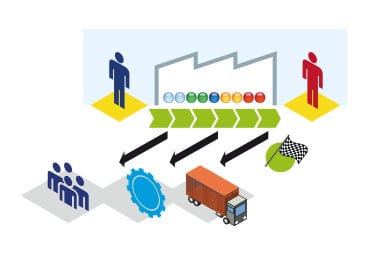On the Benefits of Reference Sequencing
Nick Ostdick - December 20, 2016

 Order planning in aggregate and component plants is a complex process, especially in today’s global supply landscape. Planners and managers have to take a number of factors into account when engaging in order planning on this level to ensure smooth, continued production programs that meet customer demand, delivery dates and quality control benchmarks.
Order planning in aggregate and component plants is a complex process, especially in today’s global supply landscape. Planners and managers have to take a number of factors into account when engaging in order planning on this level to ensure smooth, continued production programs that meet customer demand, delivery dates and quality control benchmarks.
Streamlining and enhancing the efficiency of order planning as part of lean manufacturing principles is a core driver for OEMs and manufacturers in fostering a responsive, transparent, and agile supply stream — all of which result in increased E2E visibility across a company’s entire value chain.
As traditional supply chains with large inventory buffers become more and more a thing of the past in favor of inventory-free supply streams, planners and managers require a fully-integrated, optimized planning solution to create stability and reliability in the planning and production stages. This is where a reference sequencing solution is a critical value proposition for OEMs and manufacturers in adapting to a reengineered supply network where concepts like pull control, just-in-time sequence processes, and trailer-yard strategies are more and more the norm. The result of implementing a reference sequencing solution is an optimized production program that accounts for resource allocation and assembly restrictions on the path towards creating an inventory-free mode of delivery to customers.
With this in mind, let’s examine the capabilities of a reference sequencing solution and some of the benefits OEMs and manufacturers can expect to gain from deploying this kind of planning solution in today’s modern supply stream.
Capabilities of Reference Sequencing
A reference sequencing solution, at its base, provides planners and managers with a cumulative timeline for different demand levels and delivery timetables, both of which are important cornerstones of internal planning strategies. Even at the beginning of production programs, reference sequencing accounts for a variety of production cycles and work schedules to help create a more accurate demand outlook for any given plant or production facility. The latest possible start of assembly based on customer demand can then be calculated, no matter whether an order has a short or long-term cycle. This not only helps planners and managers leverage more effective practices for trailer loading, but it also allows them flexibility in regards to the rules and restraints of any given production program.
While a reference sequencing solution can be a complex process or platform, it provides planners and managers with stability in workflows, high-speed solutions to trouble areas, and planning stability across a production network. Reference sequencing solutions also have the capacity to:
- Reduce works in progress and relinquish finished product stock. The accurate interfacing with customer demand and the possibility of inventory free integration into the supplier network creates the conditions necessary for being able to relinquish decoupling stock in shipping. This reduces funding commitment in the plant, shortens cycle times, and reduces logistics and handling costs.
- Increased productivity by improved work content balancing. Equal distribution of work content through line balancing on the basis of assembly times per each aggregate plant enables the reduction of manpower and output. This balancing of allocated jobs and orders ensures smooth, disruption free production programs aligned with specified delivery dates and timetables.
- Reduction of buffers and stock throughout the supply network. The generation of consistent and balanced production programs with regards to capacity restrictions reduces the need for lasting flexibility and stock. This applies to production process capacity in the aggregate plant itself as well as in the area of transport and supply chains, but this also helps reduce instances of fluctuations across various touch points in the supply stream.
Benefits of Reference Sequencing
Now that we understand the concept of reference sequencing and some of its capabilities in leveraging lean supply chain management principles, let’s look at a few of the concrete benefits OEMs and manufacturers can expect to gain from implementing a reference sequencing solution. As we discussed in the opening, a large part of what makes reference sequencing such a value proposition is its ability to cut through the complexities of planning tasks at the aggregate and component plant level. This is achieved by providing planners and managers with:
- Increases in assembly line productivity in both upstream and downstream areas. Reference sequencing creates an optimized, buildable, and reproducible production plan. Bottlenecks and troubleshooting measures in the assembly, upstream and downstream regions are identified before they become problematic and are thus avoided. Streamlined operation of the entire process leads to noticeable time and cost savings combined with higher productivity in production and logistics.
- Inbound and outbound cost savings. Reference sequencing helps planners and managers create an optimized plan with regards to capital commitment and handling costs. This is done through the detailed display of plant order processes, taking into account inbound and outbound restrictions. In addition, JIS supply chains can be built in high variance areas without an inventory layer towards the customer.
- Holistic synergy across the value chain. Reference sequencing optimizes structured and efficient processing of the planning process. By means of integrated restriction figures, the planner can dispense with much of manual rework often associated with planning. The algorithm efficiency during sequencing speeds up the planning process, which allows planning divisions to be pooled and synergies to be unlocked for greater efficiency and productivity.
As the automotive supply network becomes more global and disparate with hubs and facilities spread across the world, the need for a reference sequencing solution becomes more and more vital for OEMs to remain competitive in a crowded, growing marketplace. The value proposition of a reference sequencing solution not only applies to planned production and planning stages, but it can also have significant impacts on a company’s operations across various touch points of the value stream.
LATEST POSTS
- Understand Circular Economy in The Manufacturing Industry
- How Can Industry 4.0 IT Integration Be Achieved Smoothly?
- The Significance of Order Sequencing in Discrete Manufacturing
- How to improve your Supply Chain Management: The Power of Control Towers
- Optimizing Human Resource Scheduling in Manufacturing: A Technological Approach



